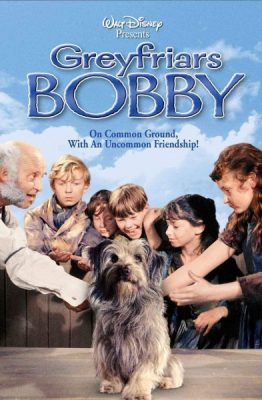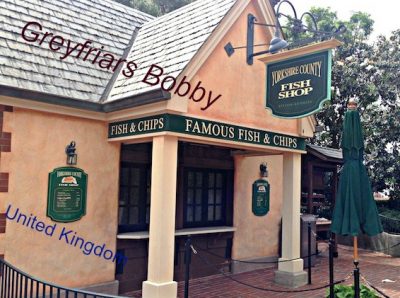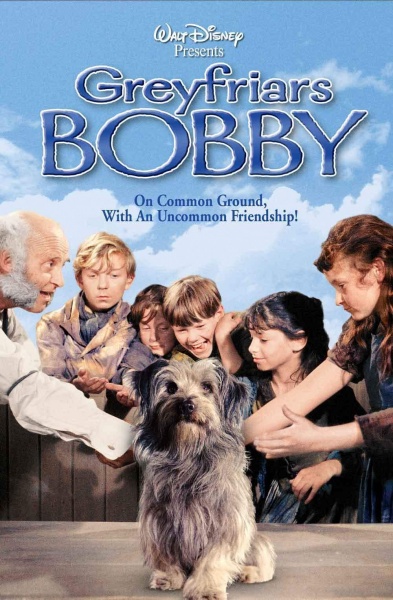
Based on Eleanor Atkinson’s 1912 novel of the same name, which was itself based on the real story of a nineteenth-century Skye Terrier who dutifully guarded his late owner’s Edinburgh grave for fourteen years, Disney’s Greyfriars Bobby was theatrically released on July 17, 1961. The live action drama is ninety-one minutes in length.
Plot Summary
In 1865 Scotland, an elderly shepherd named Auld Jock (Alex Mackenzie) is laid off from his job at Cauldbrae Farm, about thirty-five miles outside of Edinburgh, because the farm owner (Gordon Jackson) is enduring financial difficulties. Frustrated, but understanding the situation, Jock departs for Edinburgh, and the rest of the family, including the mother (Rosalie Crutchley); the son, Wattie (Iain Davidson); and the daughter, Elsie (Jennifer Nevison), prepare to move on with their lives…the rest of the family save for Bobby, the household’s Skye Terrier, that is. You see, having grown attached to the old shepherd, Bobby flees the farm, sprints the distance to Edinburgh, and reunites with Jock, who, having contracted pneumonia, tragically dies in his sleep at an inn that night. Jock possesses no personal property except for a bible, but an inscription in that book indicating that his real name was John Gray proves sufficient to provide for a proper burial in the prestigious Greyfriars Kirkyard.
In spite of Jock’s death, Bobby ignores the saying “until death do us part” and personifies a postman—for almost two years, through the spring of 1867, neither sleet, snow, rain, nor any other form of inclement weather prevents the dog from sleeping on Jock’s grave each night and hustling at exactly 1:00 each afternoon to the booth in the restaurant of the kindly John Traill (Laurence Naismith) where Jock used to eat dinner on market days. In fact, after Jock’s death, Bobby proves to be more than one man’s best friend. Indeed, Mr. Traill, kirkyard keeper James Brown (Donald Crisp), and the poor children of the neighborhood, most notably Tammy (Vincent Winter) and Ailie (Joan Buck), each find happiness in the dog’s presence.
Unfortunately for all parties, however, the dog’s life becomes imperiled. In May 1867, Sergeant Davie Maclean (Duncan Macrae) reveals a new law whereby any canine without a proper owner must be seized and put to sleep, and because Bobby moves between the homes of Traill and Brown but sleeps in neither of their houses, no one person can claim ownership and pay the seven-schilling fee for a license. Can the situation be settled and Bobby’s life saved?
Character Development
Greyfriars Bobby is undoubtedly heartwarming, but the film could have been improved with better character development. To this end, the backgrounds of the major players, especially Jock, Brown, Traill, and the children, are presented superficially, so we do not sympathize with these characters to a maximum extent. A possible solution to this problem would have been to eliminate the scenes concerning Cauldbrae Farm, instead setting the whole film in Edinburgh. In this case, segments showing the connections among the old man, Bobby, and the other urban characters could have been added, and the characters from the farm could have been eliminated.
The Cauldbrae characters, despite their employment of Jock and their ownership of Bobby, disappear after the middle of the film, and no conclusion concerning their situation is provided. To compensate for the roles played by the farmers, Jock could have been afforded another occupation in Edinburgh or have been merely presented as a local pauper. In fact, the most common telling of the story has Jock employed as a gardener and a night watchman in Edinburgh, not as a shepherd. (1)
These complaints notwithstanding, the inclusion of the Cauldbrae scenes does benefit Greyfriars Bobby in two ways. First, the rural setting allows for some beautiful vistas of the Scottish countryside. Additionally, the thirty-five-mile distance between the farm and Edinburgh that Bobby travels on two occasions provides stark evidence to the viewer about Bobby’s care for Jock.
Pollyanna
Bobby’s effect on Edinburgh is comparable to the title character’s effect on Harrington in Pollyanna (1960), though the canine’s role is subtler than that of Pollyanna. At the time of Jock’s death, Edinburgh is plagued by discord, with Traill, Brown, Maclean, and the children showing varying degrees of contempt for one another. After Bobby becomes entrenched in town, however, harmony and concern for the city’s general welfare become apparent among its inhabitants. This greater concern for the happiness of others is shown through Traill’s employment of the poor children in his restaurant, Traill’s successful effort to have the poor but intellectually promising Tammy admitted to Heriot’s Grand School, and the successful efforts of the children to raise sufficient funds to obtain a license for Bobby.
Property
The payment of a license for Bobby is complicated by the fact that the dog serves his purpose as public property, not as private property. As such, although Traill and Brown possess the requisite funds for a license, the conclusion of a deal by either man would elevate personal aggrandizement over the happiness of the larger community, and neither man is comfortable making this tradeoff.
Humor
Greyfriars Bobby has no uproarious moments, but the film does offer some potential for laughs.
In his last living moments, an enthusiastic Jock has Bobby follow his commands to, respectively, beg for his supper, rise, and die for his country. Unfortunately for the duo, the other inhabitants of the boardinghouse are not so content with the barking that arises from Jock’s playfulness.
Traill enjoys an indoor picnic with the children.
Traill makes some amusing comments during his initial hearing in the Municipal Court of Edinburgh. First, in response to Maclean’s description of Traill’s efforts to shelter the unlicensed Bobby— “I followed the said dog into Mr. Traill’s place and saw the said dog eating there and being sheltered by the accused, who did not deny the presence of the said dog”—the restauranteur makes light of Maclean’s frequent use of the adjective “said.” To this end, Traill replies, “There’s an awful lot of “said” about this wee dog. Did he no’ say anything to you?”
Later, at the end of the same court session, Traill scolds Maclean, making reference to the fact that public tax money pays the latter’s salary: “Davie, the next time you’re near my dining rooms, come in and let the wee dog you’re persecuting gi’ you a lesson in manners and morals. Bobby at least has never bit the hand that feeds him, but you have, Davie, and you’ve had many a free meal from me.”
Relationship to Other Disney Films
Dogs also played major roles in Lady and the Tramp (1955), Old Yeller (1957), The Shaggy Dog (1959, 2006), One Hundred and One Dalmatians (1961), Nikki, Wild Dog of the North (1961), Big Red (1962), The Incredible Journey (1963), The Ugly Dachshund (1966), The Biscuit Eater (1972), The Shaggy D.A. (1976), The Fox and the Hound (1981), Oliver and Company (1988), White Fang (1991), Homeward Bound: The Incredible Journey (1993), White Fang 2: Myth of the White Wolf (1994), Homeward Bound II: Lost in San Francisco (1996), 101 Dalmatians (1996), Air Bud (1997), Air Bud: Golden Receiver (1998), 102 Dalmatians (2000), Snow Dogs (2002), Beverly Hills Chihuahua (2008), and Bolt (2008).
Rob Roy, The Highland Rogue (1954), Kidnapped (1960), and The Three Lives of Thomasina (1963) are also set in Scotland.
Donald Crisp had previously appeared in Pollyanna for Disney.
Laurence Naismith had previously appeared in Third Man on the Mountain (1959) for Disney, and he subsequently contributed to The Three Lives of Thomasina for the studio.
Alex Mackenzie, who portrays the Lord Provost in the final scenes of Greyfriars Bobby, also appeared in Kidnapped and The Three Lives of Thomasina for Disney.
Duncan Macrae had previously appeared in Kidnapped for Disney.
In the Parks
Scotland is part of the United Kingdom, and guests at Epcot’s World Showcase can enjoy related dining, shopping, and architecture at the United Kingdom Pavilion.

Adventures by Disney will be offering a Scotland itinerary in June and July 2019.
Graveyards are present at the “Haunted Mansion” attractions at Walt Disney World’s Magic Kingdom, Disneyland Park, and Tokyo Disneyland Park; and at the “Phantom Manor” attraction at Disneyland Park Paris.
Overall
Greyfriars Bobby lacks in character development, but the film is nonetheless heartwarming, and the ending will make you smile.
Notes
1) Ben Johnson, “Greyfriars Bobby,” Historic UK, accessed November 20, 2018, https://www.historic-uk.com/HistoryUK/HistoryofScotland/Greyfriars-Bobby/.
What do you think of Greyfriars Bobby? Let me know in the comments!
Incoming search terms:
- https://www themouseforless com/blog_world/movie-review-greyfriars-bobby/
- cauldbrae farm


Hi.In 1973 or so, on TV I watched Grayfriers Bobby.I saw a added ending where a voice over tells the
date of dogs death, and the statue built for him.This is not on the DVD.I saw it once,never again,did I dream it?Very interested on info on this.